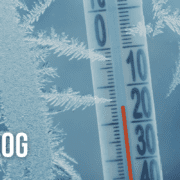Impact of Cold Temperatures on Your Cooling System

Coolant analysis can shed light on developing internal problems and catch concerns early before harmful problems can occur. Making the proper adjustments, when needed, is critical for maintaining proper cooling system performance.
How do Temperatures Affect Coolant?
When outside temperatures drop, proper freeze protection is required to avoid freezing or lack of coolant flow within the cooling system. When coolant freezes, it is most likely due to improper water-to-glycol ratio in the cooling system. Freezing can cause cracking and damage to the engine block and/or cooler allowing coolant and lubricant to mix. Once lubricant and coolant mix, further damage to the asset will occur leading to an expensive unexpected repair.
Finding the Proper Glycol Mixture
The proper glycol mixture with the water is crucial. Testing and maintaining the proper dilution provides a lower freeze protection, while also maintaining proper coolant properties. Water by itself has a freeze point of 32 degrees Fahrenheit (0 degrees Celsius). Using only water or too much water dilution will lower other coolant protection properties and can lead to system corrosion and lower than desirable pH control. However, too much glycol can cause the coolant to become too viscous, slow down coolant flow within the system and an over-saturation of corrosion inhibitors resulting in a precipitation concern. Plugging and/or inadequate coolant flow will impact proper protection for the cooling system and increase the time needed for the engine to reach proper operating temperatures. Lubricant not reaching proper temperatures allows for more metal-to-metal contact and engine wear concerns.
Routinely Test Your Cooling System to Avoid Problems
Overall, roughly 40% or so of preventable engine failures occur due to the cooling system not functioning properly. Most concerns in the cooling system are created by improper maintenance of the cooling system and coolant in service. Coolant chemistry reactions occur due to mechanical issues, coolant properties not being maintained and/or contamination of the system.
Learn more and find answers to your coolant testing and analysis questions here.
A proper fluid analysis program should include testing all fluids in the asset to have a better understanding of the fluid and equipment health. With trend analysis, you can catch concerns easier and faster and be able to take action on the proper recommendations to identify and address the issue before you have expensive, unexpected equipment downtime.
Winter temperatures should not keep your equipment out of service. Reach out today and pull a coolant sample to take out the guesswork out of knowing if the coolant in the system meets requirements for properly protecting your cooling system.

Proven Impact. Proven Uptime. Proven Savings.
Let us prove it to you.
Published January 10, 2023





